
Neil Armstrong’s Response to Apollo 11 Patch Concepts at Auction
Unlocking the Mysteries of Neural Networks
Welcome to the fascinating world of neural networks, where machines are learning to think, recognize patterns, and sometimes even outsmart us. To kick off, you should rest assured: grasping the fundamentals isn’t as daunting as memorizing your multiplication tables—or attempting to decipher the latest trends in artisanal pickles.
So let’s dive into this intriguing canvas, shall we?
Firstly, neural networks are not some sci-fi figment of our imagination, lurking in our gadgets like unsuspecting ninjas. No, they’re a structured framework designed to process information in a way that mimics human brain function (but with much less existential dread). Imagine a web of neurons, complete with an electrical zap here and there, sending signals that help us learn. Except in the realm of artificial intelligence, the “electrical zap” equates to mathematical functions and algorithms. Trust me, it’s as riveting as it sounds.
Now, let’s clear up the confusion. Neural networks thrive on data. And we're talking about a tidal wave of data! Think oceans of numbers, images, and texts—so much information that your brain might actually catch a chill just picturing it. This data feeds the network, allowing it to identify patterns and make predictions with a level of precision that would put a clairvoyant to shame. Want to know how a neural network can predict the next big thing in fashion? It analyzes massive datasets of pictures, trends, and perhaps even that awkward selfie you took at a festival in 2015.
However, feeding data into a neural network is not as simple as tossing pretzels into a bowl at a party. You need to organize it—this is where feature engineering comes in. Features are like the indispensable ingredients in your grandma’s legendary meatloaf: measurable attributes that define the characteristics of the data you’re working with. If you’re concocting a recipe for predicting home prices, you better believe that features like square footage, number of bedrooms, and even the color of the house paint will significantly change the “taste” of your machine’s predictions.
But hold onto your hats—a neural network doesn’t just magically conjure results after you toss in some data. Enter the concept of training. Imagine encouraging your overly ambitious yet slightly clumsy toddler to ride a bike for the first time—it takes practice, balancing, and, yes, a few faceplants. Similarly, a neural network undergoes multiple iterations, fine-tuning its parameters until the output resembles a half-decent performance—so it can finally distinguish between a cat and a loaf of bread (yes, that’s indeed a thing).
Once trained, the network undergoes a validation phase—playing the role of an experienced judge at a bake-off. “Do I have what it takes to predict new scenarios?” it asks, as it encounters fresh data. Bing! If it performs well, congratulations! Your neural network has passed the test. If not—better crank up those parameters and roll up your sleeves for another round.
Curious about how these networks are structured? There’s a whole hierarchy at play! At the top, you’ve got the input layer where data enters—much like the entrance to a discounted chocolate factory. Then comes the hidden layers, where all the ‘magic with math’ happens; if you polled a few neural networks, they’d likely argue that this is where they put on their thinking caps. Finally, we reach the output layer—the grand reveal where all that hard work results in predictions. Voilà!
Let’s talk about learning algorithms—yes, they may sound like ominous scientific jargon, but they’re fundamentally the brains behind the operation. With techniques like gradient descent and backpropagation, our favorite networks undergo an optimization process that helps them minimize errors. It’s akin to adjusting your wardrobe until you nail that perfect outfit: a little tweak here, a nudge there, and voilà, you’re ready to turn heads!
Now, neural networks aren’t without their quirks. They can sometimes behave erratically, throwing unexpected tantrums—known as overfitting. Picture a dog that learns to sit every time you jingle a treat bag; it’ll know that sound inside out, but come the unsettling silence of “sit” without the bag, and whoop, you’ve got a rebellious pup on your hands. Similarly, an overfitted neural network knows the training data so well it fails to generalize to new, untested information. The trick? A robust validation set and the right regularization techniques can keep those networks in check.
But here comes the juicy part—neural networks can be applied across a myriad of fields! From healthcare, where they’re positively revolutionizing early disease detection, to finance, where they’re decoding fraudulent patterns before you can say “hold onto your wallet,” neural networks are everywhere. They even fortify the recommendations on your favorite streaming services, determining when to suggest you jump back into your comfort zone of cat memes or dark thrillers.
Still skeptical? Let’s consider the future. With the rise of automation, deep learning, and neural networks, it’s essential not to fret about job security just yet. Yes, some tasks may be handled by the machines, but the human touch will always add that irreplaceable sprinkle of empathy, creativity, and a litany of uniquely human nuances to any equation.
The neural network playground is evolving at warp speed! Every day, new breakthroughs and innovations emerge, unveiling new potentials—so immerse yourself in this journey. You’re not just a bystander; be the curious explorer who ventures down this winding path, learning, understanding, and perhaps even shaping the future along the way.
Want to stay up to date with the latest news on neural networks and automation? Subscribe to our Telegram channel: @channel_neirotoken

